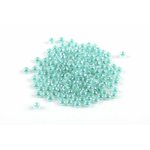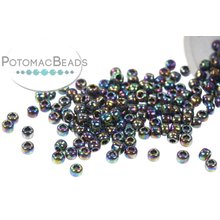- Jewelry-Making Supplies ▾
Design Jewelry with Confidence!
Seed Beads
Thread, Wire, & Stringing Materials
Findings & Components
Everything Else
- Kits & Collections ▾
Assemble Your World
Kits & Collections
- Subscriptions ▾
Want monthly Beading Happiness?
Subscriptions
- Learn to Make ▾
Want to learn more?
- Discounts & Deals ▾
Explore Today's Promotions!
-
Seed Beads
Thread, Wire, & Stringing Materials
Findings & Components
Everything Else
-
Kits & Collections
-
Subscriptions
- Home
- Seed Beads
ONLY VISIBLE ON EDIT MODE *
subtitle
page_content
videos
how to videos
Seed Beads

Seed Beads
In the vast universe of crafting, there exists a tiny hero that has captured the hearts and imaginations of artisans for centuries: the seed bead. Like minuscule droplets of color, these glass seed beads hold within them the magic of creativity, weaving stories of beauty and expression with every delicate stitch. As we delve into the world of crafting, it's impossible not to marvel at the enduring presence and versatility of these tiny treasures.
The Enduring Allure of Seed Beads
Seed beads have long been a cornerstone in the realm of jewelry making, particularly in the art of beadweaving. With their diminutive size and vast array of colors and finishes, they serve as the building blocks for intricate designs that dazzle the eye and stir the soul. From delicate bracelets to statement necklaces, seed beads lend their charm to a myriad of jewelry pieces, each one a testament to the artisan's skill and imagination.
Size Matters: Understanding Seed Beads
One of the fascinating aspects of seed beads is their diverse range of sizes, denoted by numbers such as 15/0, 11/0, 8/0, or 6/0. The higher the number, the smaller the bead, allowing for intricate detailing in beadwork. Whether you're creating a dainty pair of earrings with 11/0 seed beads or crafting a bold cuff bracelet with larger 8/0 beads, the possibilities are endless.
Exploring Creativity with Seed Beads
The beauty of seed beads lies not only in their size but also in their versatility. Beyond traditional jewelry making, these tiny beads can be incorporated into a myriad of craft projects, from embellishing clothing to adorning accessories such as handbags and hair clips. With seed beads, the only limit is your imagination.
In the vast universe of crafting, there exists a tiny hero that has captured the hearts and imaginations of artisans for centuries: the seed bead. Like minuscule droplets of color, these glass seed beads hold within them the magic of creativity, weaving stories of beauty and expression with every delicate stitch. As we delve into the world of crafting, it's impossible not to marvel at the enduring presence and versatility of these tiny treasures.
The Enduring Allure of Seed Beads
Seed beads have long been a cornerstone in the realm of jewelry making, particularly in the art of beadweaving. With their diminutive size and vast array of colors and finishes, they serve as the building blocks for intricate designs that dazzle the eye and stir the soul. From delicate bracelets to statement necklaces, seed beads lend their charm to a myriad of jewelry pieces, each one a testament to the artisan's skill and imagination.
Size Matters: Understanding Seed Beads
One of the fascinating aspects of seed beads is their diverse range of sizes, denoted by numbers such as 15/0, 11/0, 8/0, or 6/0. The higher the number, the smaller the bead, allowing for intricate detailing in beadwork. Whether you're creating a dainty pair of earrings with 11/0 seed beads or crafting a bold cuff bracelet with larger 8/0 beads, the possibilities are endless.
Exploring Creativity with Seed Beads
The beauty of seed beads lies not only in their size but also in their versatility. Beyond traditional jewelry making, these tiny beads can be incorporated into a myriad of craft projects, from embellishing clothing to adorning accessories such as handbags and hair clips. With seed beads, the only limit is your imagination.
-
Sort By
-
-
-
-
-
-
-
-
- DB1245 Miyuki Delica Beads Transparent Light Amethyst AB Size 11/0
$6.49$4.54 -
-
-
- DB1228 Miyuki Delica Beads Transparent Caribbean Teal Luster Size 11/0
$6.49$4.54 -
-
-
- DB0627 Miyuki Delica Beads Dyed Aqua Green Silver Lined Al Size 11/0
$8.19$5.73 - DB0780 Miyuki Delica Beads Dyed SF Transparent Bubble Gum Size 11/0
$7.19$5.03 -
- DB1225 Miyuki Delica Beads Transparent Light Amethyst Luster Size 11/0
$6.49$4.54 - DB1248 Miyuki Delica Beads Transparent Caribbean Teal AB Size 11/0
$6.49$4.54 -
-
-
-
- DB1308 Miyuki Delica Beads Dyed Transparent Bubble Gum Pink Size 11/0
$6.79$4.75 -
-
-
- DB0107 Miyuki Delica Beads Transparent Gray Rainbow Gold Luster Size 11/0
$7.19$5.03 -
- DB1479 Miyuki Delica Beads Transparent Pale Peach Luster Size 11/0
$6.79$4.75 -
-
-
-
-
-
-
-
-
-
- DB0312 Miyuki Delica Beads Matte Metallic Dark Raspberry Size 11/0
$11.89$8.32 -
- DB1475 Miyuki Delica Beads Transparent Pale Sky Blue Luster Size 11/0
$6.79$4.75 -
-
-
- DB0101 Miyuki Delica Beads Light Smokey Topaz Gold Luster Size 11/0
$6.49$4.54 -
-
-
- DB0246 Miyuki Delica Beads Dark Cotton Candy Pink Ceylon Size 11/0
$6.49$4.54 -
- DB0787 Miyuki Delica Beads Dyed SF Transparent Capri Blue Size 11/0
$7.19$5.03 -
- DB1229 Miyuki Delica Beads Transparent Ocean Blue Luster Size 11/0
$6.49$4.54 -
-
-
-
- DB0111 Miyuki Delica Beads Transparent Blue Gray Rainbow Gold Luster Size 11/0
$7.19$5.03 -
-
-
-
-
-
- DB0788 Miyuki Delica Beads Dyed SF Transparent Dark Teal Size 11/0
$7.19$5.03 -
-
-
-
-
FAQ
FAQ
Navigating the World of Seed Beads
Navigating the World of Seed Beads
-
What is a seed bead?
Seed beads are small glass beads commonly used in crafting. They come in various sizes, ranging from the very tiny 15/0 to the larger 6/0. These beads are named for their resemblance to seeds and are frequently employed in intricate patterns or simple stringing to add color and texture to projects. Despite their small size, seed beads have a big impact, transforming ordinary projects into stunning works of art.
-
What are the different types of seed beads?
Seed beads come in various types, including Czech seed beads, Japanese seed beads, Japanese cylinder beads, and Chinese seed beads. Each type offers its own unique characteristics in terms of origin, manufacturing process, and quality.
Czech seed beads: Renowned for their exceptional quality and craftsmanship, Czech seed beads are produced in the Czech Republic using traditional techniques passed down through generations. They often feature intricate designs and vibrant colors, making them a favorite among artisans who seek high-quality beads for their projects.
Japanese seed beads: Japanese seed beads, namely Miyuki seed beads, are prized for their consistency in size and shape, making them ideal for intricate beadweaving projects. Manufactured with precision using advanced technology, these beads offer a wide range of colors and finishes, allowing artisans to create stunning jewelry pieces with flawless detail.
Japanese Cylinder Beads (Delica Beads): Delica beads, also known as Japanese Cylinder Beads, are renowned for their uniform size and shape. Their cylindrical form and precise dimensions make them perfect for intricate beadwork such as peyote stitch and brick stitch. Delica beads are favored by artisans who require precision and uniformity in their designs.
Chinese seed beads: Chinese seed beads are valued for their affordability and wide range of colors and finishes. Produced in China using modern manufacturing techniques, these beads offer a cost-effective option for artisans who seek a vast selection of beads for their projects. While they may vary slightly in size and shape compared to Czech and Japanese seed beads, they still provide excellent quality for various crafting projects.
Each type of seed bead brings its own unique characteristics to the crafting table, allowing artisans to explore different textures, colors, and finishes in their creations. Whether you prefer the traditional craftsmanship of Czech seed beads, the precision of Japanese seed beads, the uniformity of delica beads, or the affordability of Chinese seed beads, there's a perfect bead for every piece of seed beads jewelry.
-
What can you do with seed beads?
Seed beads are incredibly versatile and can be used in a multitude of crafting projects. From creating intricate jewelry pieces like bracelets, necklaces, and earrings to embellishing clothing, accessories, and even home decor items, the possibilities are endless. Whether you're a seasoned beader or a curious beginner, seed beads offer a world of creative exploration. Additionally, PotomacBeads provides a wealth of resources for bead enthusiasts, offering patterns, video tutorials, and beadweaving starter kits to help crafters unleash their creativity and bring their visions to life.
-
What is the difference between seed beads and Czech beads?
Seed beads are small glass beads commonly used in crafting. They come in various sizes and are often used in intricate beadwork, such as beadweaving. While some seed beads are made of Czech glass, it's essential to note that Czech beads encompass a broader category of glass beads originating from the Czech Republic. These beads include a wide range of styles, shapes, and finishes beyond traditional seed beads. So, while some seed beads are indeed Czech glass, not all Czech glass beads are seed beads.
-
What is the difference between Toho and Miyuki seed beads?
Toho and Miyuki, esteemed brands hailing from Japan, stand out in the world of seed beads, each possessing distinct attributes. Both brands provide top-tier seed beads, yet nuances set them apart. Miyuki beads exhibit remarkable uniformity, boasting a cylindrical shape and larger holes, perfect for intricate bead weaving and embroidery projects. Conversely, Toho beads, renowned for their round shape and smaller holes, excel in bead looming and stringing endeavors. In terms of pricing, Toho beads generally offer a more budget-friendly option compared to Miyuki beads. Ultimately, the choice between Toho and Miyuki boils down to personal preference and the specific needs of your project. Whether you opt for the precision of Toho or the diversity of Miyuki, both brands guarantee exceptional quality and endless creative possibilities.
-
What is the difference between seed beads and delica beads?
Seed beads and delica beads are both used in beadweaving, but they differ in shape and size. Seed beads have a rounded shape, while delica beads are cylindrical. Delica beads are also known for their uniform size and shape, making them ideal for precise beadwork.
-
What are the different sizes of seed beads?
Seed beads come in a range of sizes, denoted by numbers such as 15/0, 11/0, 8/0, and 6/0. The size of a seed bead indicates its diameter, with smaller numbers representing larger beads. For example, 15/0 seed beads are tiny, almost microscopic beads, while 6/0 seed beads are larger and more substantial. Here's a handy chart to illustrate the average sizes of seed beads:
Seed Bead Size Diameter (mm) 15/0 1.3 11/0 2.1 8/0 3.0 6/0 4.0 Each size offers its own unique possibilities for crafting, allowing artisans to tailor their creations to their desired style and vision.
Highest Quality
Products
100% Money
Back Guarantee
Fast
Shipping
Best Teaching &
Customer Service
You'll want these emails...
Get Free Projects & Inspiration
Get Free Projects & Inspiration
- Bullet 1
- Bullet 2
- Bullet 3
-Transparent.png)
240 N Prospect St. Hagerstown, MD 21740
(301) 393-4667
hello@potomacbeads.com
Copyright © PotomacBeads

















































































